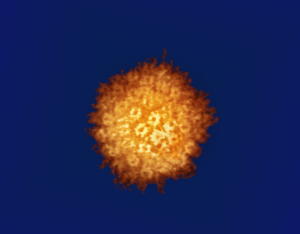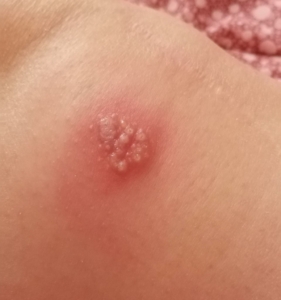Gene therapy shows promising results in eliminating Herpes Simplex Virus infections
In a groundbreaking study published in Nature Communications [1], researchers at the Fred Hutchinson Cancer Center have reported encouraging findings from pre-clinical studies on an experimental gene therapy for genital and oral herpes infections caused by the herpes simplex virus (HSV).

Colourized electron micrograph of the herpes simplex virus
The Approach: Gene Editing and Targeted Vector Delivery
The gene therapy involves injecting a mixture of gene-editing molecules into the bloodstream. This mixture consists of laboratory-modified viruses called vectors, commonly used in gene therapies, and enzymes known as meganucleases that act as molecular scissors.
Once the vector reaches the clusters of nerves where the herpes virus resides, the meganucleases snip away at the herpes virus’s DNA, damaging its genes or removing the virus entirely. Specifically, a single meganuclease enzyme is designed to cut the HSV DNA in two different locations, causing extensive damage that the virus cannot repair.
The body’s natural DNA repair mechanisms then recognize the damaged viral DNA as foreign and eliminate it.
Significant Viral Load Reduction and Shedding Suppression
Using mouse models of HSV-1 infection, the experimental therapy demonstrated remarkable efficacy in reducing viral loads. After facial infection (oral herpes), a 90% reduction in HSV-1 levels was observed, while a 97% reduction was achieved in genital HSV-1 infections.
The researchers noted that it took approximately a month for the treated mice to show these reductions, and the reduction of the virus appeared to become more complete over time.
Furthermore, the gene therapy led to a significant reduction in both the frequency and amount of viral shedding, which is crucial for preventing transmission to others.
Streamlined and Safer Approach
The researchers have also simplified their gene-editing treatment, making it safer and easier to manufacture. In a previous 2020 study, they used three vectors and two different meganucleases. The latest study employs just one vector and one meganuclease capable of cutting the virus DNA in two places.
This streamlined approach is not only effective at eliminating the herpes virus but also has fewer side effects on the liver and nerves, suggesting that the therapy will be safer for human use and easier to produce.
Preparing for Clinical Trials and Expanding to HSV-2
While the researchers are encouraged by the promising results in animal models and eager to translate the findings to treatments for humans, they are cautiously moving forward and collaborating with numerous partners to align with federal regulators and ensure the safety and effectiveness of the gene therapy.
Additionally, although the current study examined HSV-1 infections, the team is working on adapting the gene-editing technology to target HSV-2 infections, which cause genital herpes.
Significance and Future Directions
Herpes simplex virus infections are highly prevalent globally, with an estimated 3.7 billion people under the age of 50 (67%) infected with HSV-1 and 491 million people aged 15-49 (13%) infected with HSV-2 worldwide, according to the World Health Organization.
Current therapies can only suppress symptoms, such as painful blisters, but cannot eliminate the virus entirely. HSV-2 also increases the risk of acquiring HIV infection, and studies have linked HSV-1 to dementia.
The potential development of a curative gene therapy for herpes infections would be a significant breakthrough, offering hope for millions of people living with these lifelong infections and reducing the risk of transmission and associated health complications.
The researchers express deep appreciation for the support of herpes advocates who share their vision for curing these infections and are collaborating with numerous partners as they approach clinical trials.
Reference:
1. Aubert, M., Haick, A.K., Strongin, D.E. et al. Gene editing for latent herpes simplex virus infection reduces viral load and shedding in vivo. Nat Commun 15, 4018 (2024). https://doi.org/10.1038/s41467-024-47940-y


